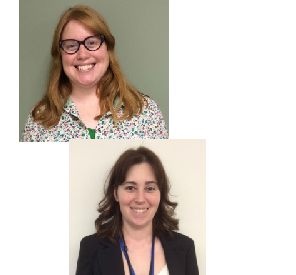
Presenters: Jennifer Driscoll (top) and Ann Marie Hurtado (bottom)
Two Pasadena (CA) Public Library (PPL) youth services librarians, Jennifer Driscoll and Ann Marie Hurtado, supplied an abundance of programming directions and tips during their exhibit “Appvisory: Curating and Providing Access to Educational Apps in the Children’s Library” during The Digital Shift: Libraries @ the Center virtual conference presented by sister publications Library Journal and School Library Journal. The exhibit covered the uses of iPads and tablets in early literacy and early learning—and how librarians can be “media mentors” to both children and parents. Hurtado remarked that kids spend a lot of time on tablets and smart phones but not necessarily for educational use.
(Use the hashtag #TDS14 to follow the Libraries @ the Center thread on Twitter.)
Four Pillars of Appvisory Service
Driscoll forged on to discuss the four pillars of PPL’s Appvisory Service: eStorytime for preschool children and their caregivers; Appy Hour for school-age kids and their caregivers; iPad stations in the Children’s Room; and online presence parents can consult at home. Setting up Appvisory Service requires some investment in hardware and equipment, said Hurtado, including:15 iPads (two to be used to plan programs), four iPad stations in the Children’s Room, nine iPads for Appy Hour, Apple TVs, and wireless networks. (Hurtado also acknowledged the importance of enlisting the library’s IT people about Apple volume purchasing and getting the necessary apps.)
eStorytime
Delving into the programming, Driscoll explained PPL’s all-app eStorytime—with a separate regular storytime for those parents who don’t want their kids to have screen time. She demonstrated the “eStorytime Formula” in a slide—a general step-by-step guide that contained instructions such as: “Welcome song projected in Keynote”; “Interactive app that introduces the theme”; “Book app”; and the last step: “Show what apps we used and give handout to parents.” She also emphasized the technological difficulties that will inevitably occur during eStorytime and recommends librarians have “plenty of books on hand” and plan additional activities. Some tips? Have a variety of themes, practice apps (and mirroring), and look for book apps to pull into your theme. Lastly, she offered resources to find apps and ebooks, including littleelit.com and http://en.childrenslibrary.org.
Appy Hour
Moving on to Appy Hour, a program for school-age kids and parents to learn about educational apps, one of the librarians related how she could demonstrate quality educational app use by mirroring an iPad on a projector and walking through apps with the families attending the training, who each get 10 minutes of uninterrupted play on individual iPads at some point during the program. As with eStorytime, the librarians offered a tipsheet for an “Appy Hour Formula,” providing structure such as: “As families enter, give each family a ticket”; “Spend the first 15 minutes giving brief introductions for 8-10 quality school-age apps”; “Pass out handouts with the apps listed, along with websites for finding more.” Hurtado offered additional tips for planning Appy Hour. “You want to have an elevator speech for each app you are recommending,” she said and stressed the importance of taking the time to familiarize yourself with the apps. She pointed out trusted app review sites—including SLJ’s and theimum.com.
Also, she said, don’t let parents/caretakers leave the programs empty-handed. Hurtado showed a slide illustrating two handouts, one containing apps reviewed during Appy Hour and another handout of “App Selection Tips.” Plus, she encouraged, take advantage of “Free App Friday,” a day when many app developers drop their prices. To find out what apps are free during these promotions, subscribe to bestappsforkids.com and smartappsforkids.com.
ipad stations and online presence
Driscoll touched upon creating iPad stations in the library as a cheaper alternative to early literacy stations—and talked about some of the nuts and bolts that go into creating secure iPad stations, such as tethering the iPads to tables, as well as disabling app stores, YouTube, and Safari. She recommended thinking ahead to answer questions about collecting usage statistics, providing headphones, and how long children may use the stations (and whether there should be sign up).
Lastly, the two women spoke of marketing and outreach: PPL has Pinterest boards containing app recommendations for both preschool (2–5) and ages 6 and up—plus one for research on digital media. More marketing and outreach tips? Create flyers and target appropriate interest groups among churches, homeschooling families, afterschool programs, and teachers and families on back-to-school nights; and integrate catchy marketing over social media, including your library’s Facebook page.
“Librarians are the perfect people to offer advice and support [for apps],” said Driscoll, who pointed out that librarians already possess the expertise for app selection and curation.
To view the slides to this exhibit, log in (or register) at The Digital Shift: Libraries @ the Center.

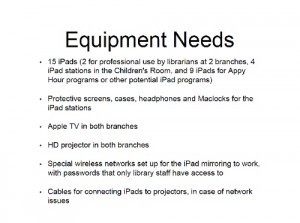
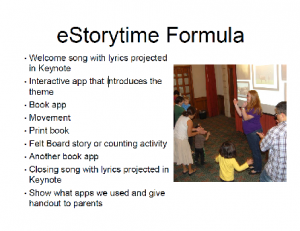
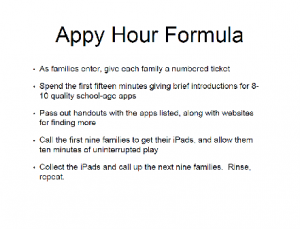
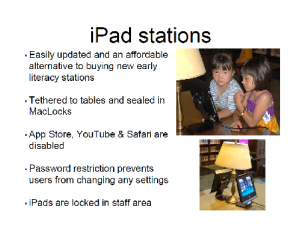


Great information, wonderfully organized and presented! Thanks!